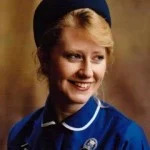
'Who am I?' - The story of Helen Cherry, Deaf Nurse, Manager and Student
‘Who am I?’ – The story of Helen Cherry, Deaf Nurse, Manager and Student
Who am I?
I am a 55-year-old woman, a wife, daughter, sister, aunt and a Community Health Professional. I am also passionate about removing communication barriers so information is accessible to all.
Due to a childhood illness I am deaf and I wear bilateral hearing aids. When I take them out at the end of the day I love the silence. However, hearing aids are not a cure and do not provide perfect clear hearing, so I also rely on my other senses and gut feeling to help me communicate and engage with my environment. I lip read, am intuitive and pick up on the many clues and vibrations all around me.
How did I get into nursing?
Thanks to Brighton School of Nursing, I became one of the first deaf nurses in 1977. When others would not even give me an interview, Brighton School of Nursing provided me with an opportunity to start my profession. They were not afraid to step into the unknown with an open honest attitude, and for that I am thankful.
I wanted to gain independence, travel and use my personal experiences to help those I would care for. I know how it feels to be misunderstood when you want to be listened to, and what the impacts of unconscious bias can be.
Why this introduction?
I could have started this article with examples of how the Equality Act has increased opportunities for anyone within the diverse spectrum of mental health, disability, culture, faith, race and sexuality.
However, I wanted to paint a picture first and then ask you, the reader, to be truthful and think about whether there was a moment when you thought, “Is a deaf nurse a risk to patients?”
There was a time when just saying I am a blonde blue-eyed woman conjured up all sorts of stereotypes. Add into the mix that I am deaf and the words ‘dumb’ or ‘stupid’ often come up.
As a deaf professional I know my abilities, and there is a solution to every challenge.
What defines me?
A few months ago someone asked me whether my husband, family or friends see me as deaf. The answer is no. Being deaf is not what defines me, it’s being Helen Cherry that does. I am defined by my attitude, independence, love, empathy, cooperative approach, solution-seeking mindset and pioneering manner – anything is possible!
Normalising ways of working
Everyone has a different story to tell about their personal experiences of being deaf, and dealing with disability in the workplace. However, my angle focuses on what we can do in everyday life to ‘normalise’ special requests to adapt ways of working.
With advances in technology, building design and organisational structures, this should be a time when all special adjustments can be incorporated as part of the norm.
My biggest bugbears are videos. When will it become the norm for all videos to embed correct subtitles that can be switched on and off? Or use sign language for those who have BSL as their first language?
Any videos uploaded onto company or health websites need to be captioned for inclusion. This doesn’t just provide me with access – it’s also educational learning for others. When information is provided clearly it reduces errors and mistakes caused by miscommunication and assumptions.
From my personal experiences, here are few things that cause me difficulty, yet could be resolved easily and with fairly little cost:
- Make sure external venues know how to use the induction loop. For those without hearing aids, or who do not have aids that are compatible with induction loops, a speech to text reporter (STTR) can be provided, which converts real time speech into text. However, be mindful of those who use British Sign Language (BSL) as their first language, as it is very different to English.
- Reflective glare from too many windows can cause faces to be blanked out, which makes it impossible to lip read anyone. Watch me do a little dance as I reposition myself so I can see their faces!
- Use round meeting tables so I can see everyone speaking.
- Offer different communication channels other than forms and letters. FaceTime or Skype is a great way to see the person and lip read or use BSL.
- I can’t use intercom systems as I cannot hear you, so please use signage that’s clear, concise and uses colours.
- Some phone apps give a guided tour around a building, which allows me to see what facilities are available.
- Be creative and investigate all communication devices and options available – get to know your local community services. There are many adaptive apps on mobiles and wearable devices, and it is increasingly easy to access real time communication services and providers.
- Ai-Live as funded by Access to Work has been a hugely valuable tool for me in doing my job effectively. Being able to follow a conversation accurately and, crucially, in real time, has allowed me to engage with colleagues at work, lectures and events in a far more natural and direct way than I would otherwise have been able to.
If everyone did just a little bit to make sure their information was accessible the world would be so much easier for so many people. I will continue to campaign passionately for equal access to the information I, and the many millions like me, are entitled to.
Written by Helen Cherry. A version of this article first appeared here.